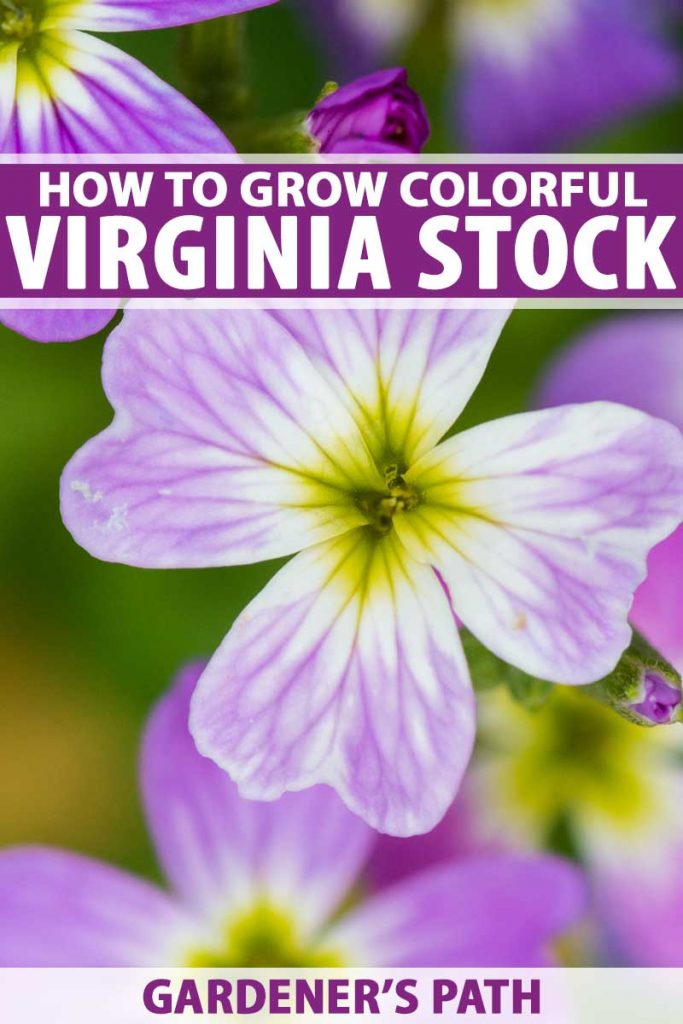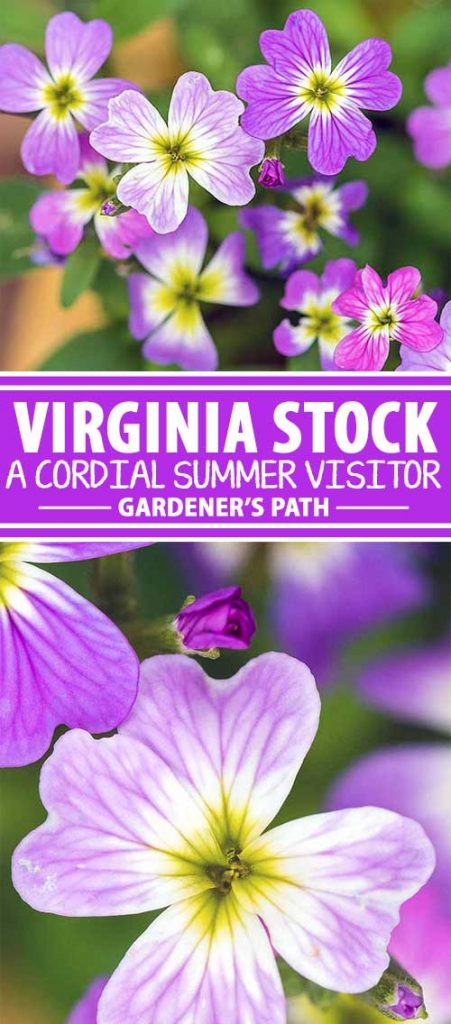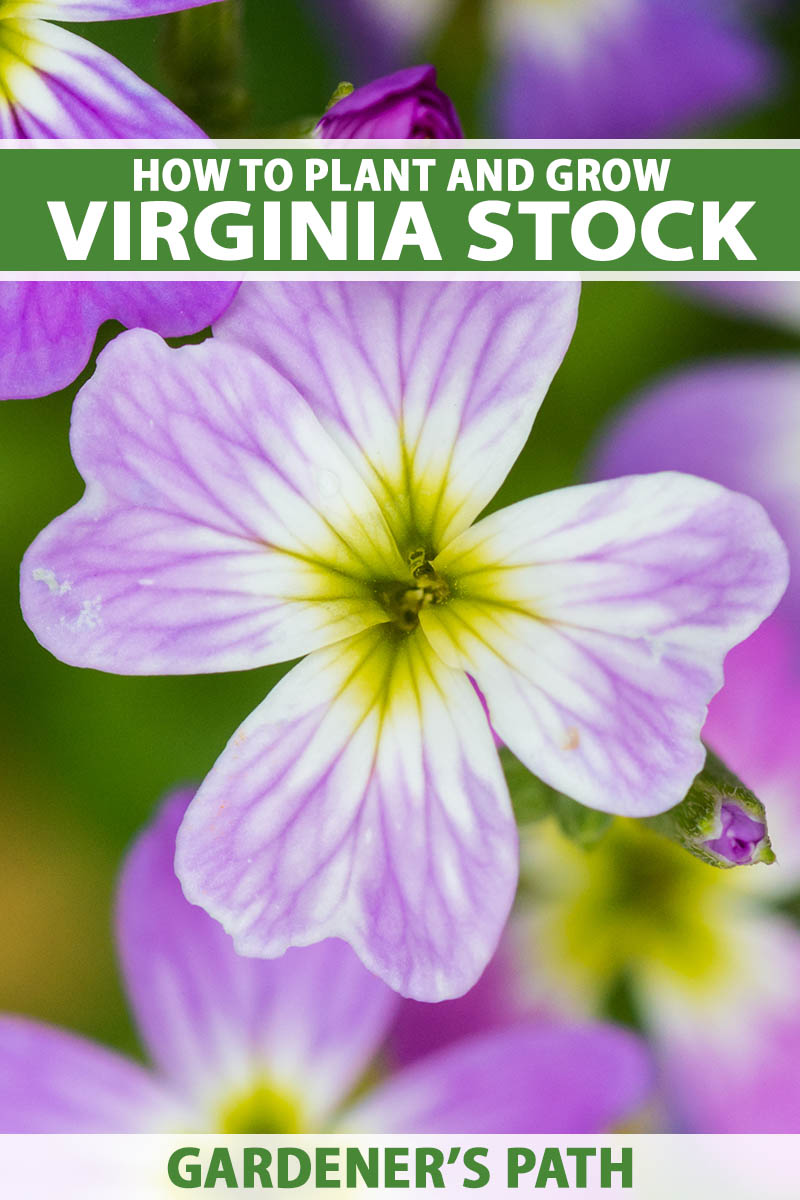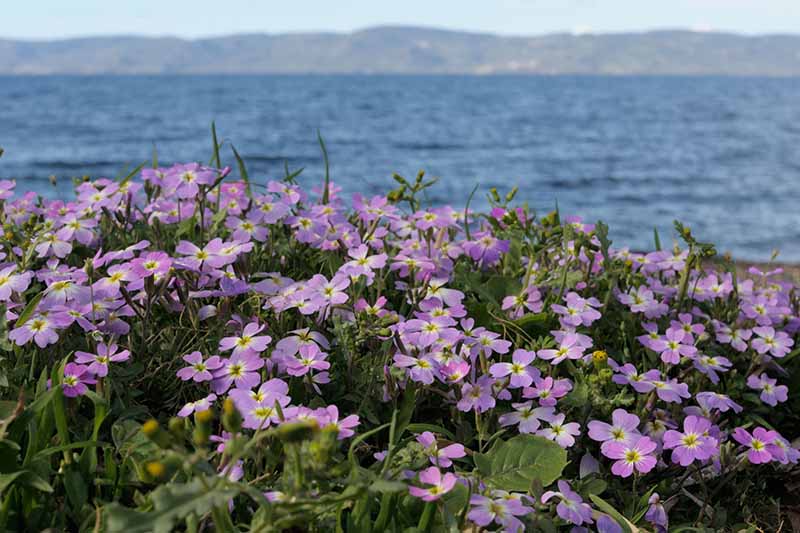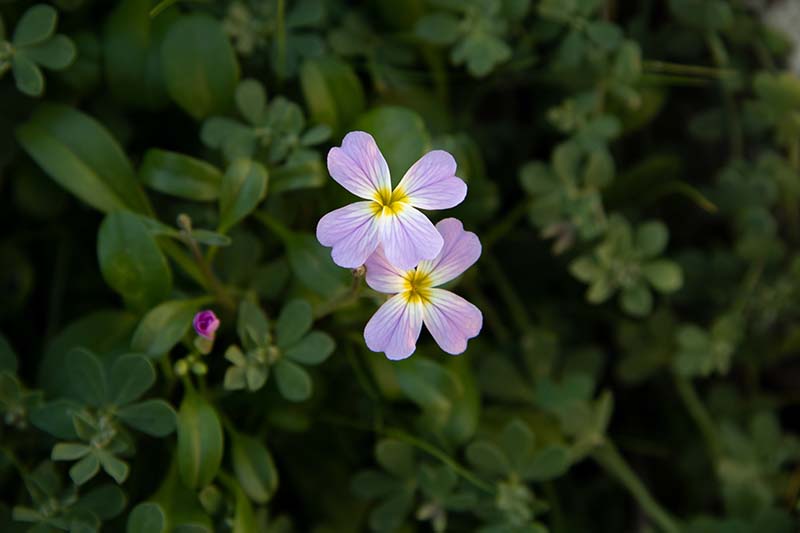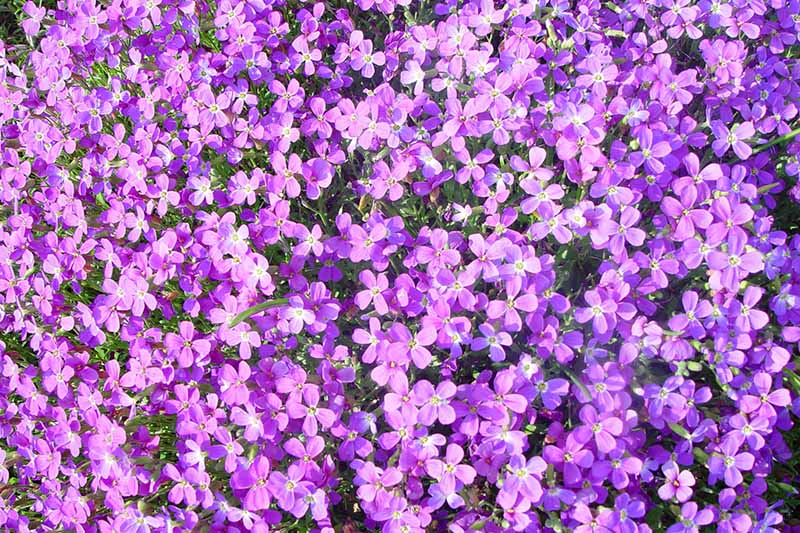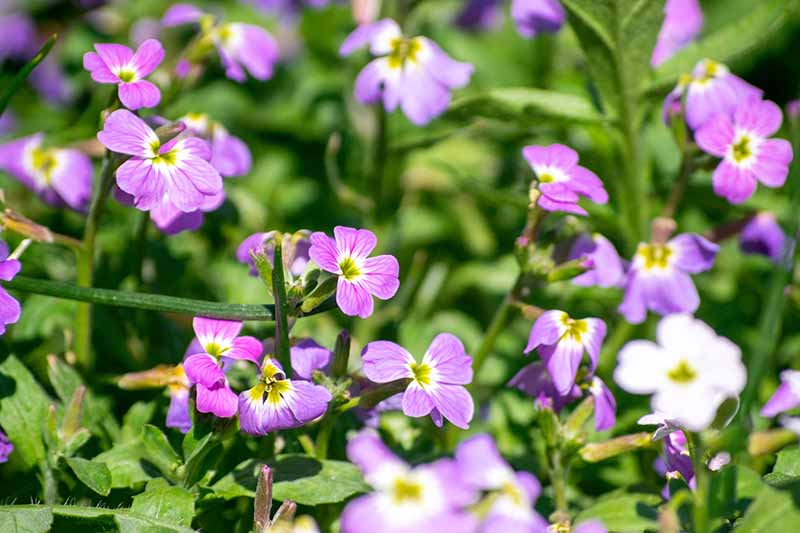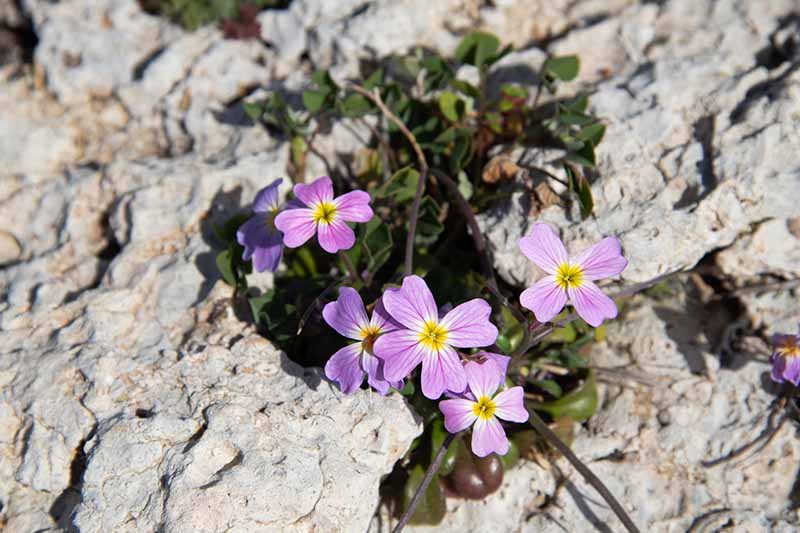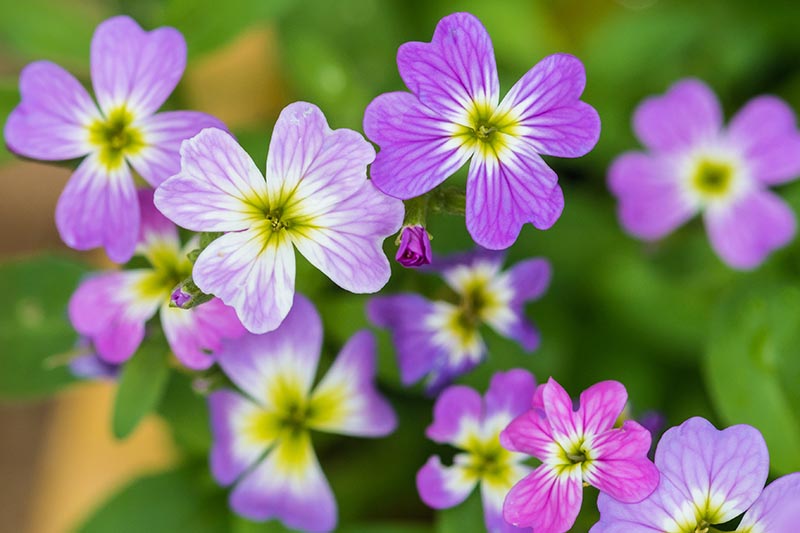Its Latin name reveals nautical origins, and in fact, it was originally found rambling along the salty shores of the Mediterranean. We link to vendors to help you find relevant products. If you buy from one of our links, we may earn a commission. A close relative of the stock plant, Matthiola incana, this plant is also commonly called gillyflower. It is easily cultivated in USDA Hardiness Zones 3 to 9. Here’s what I’ll cover: Let’s get started!
Cultivation and History
Virginia stock, aka Virginian stock, is a prolific wildflower that prefers full sun, but tolerates light shade, as well as a variety of soils, low moisture, and salt. It has an upright, clumping growth habit. Mature dimensions measure approximately six to 12 inches tall and six inches wide. The leaves are gray-green and elliptical. Fragrant four-petalled blossoms cluster at the terminal ends of upright, hairy stems. This is called a cruciform configuration, because it resembles a cross. Each flower measures approximately one inch across. The colors range from deep magenta to light pink, lavender, and white, with a yellow “eye.” There may even be some that are all yellow. Historically, the seeds of this cheerful little flower gradually made their way inland from Mediterranean shores, naturalizing in the hardscrabble soil of disturbed areas, like dumping grounds, as well as in cracks and crevices both natural and manmade. Records of M. maritima in Belgium date to the city of Leuven in 1887, a location that is more than 1,300 miles from the Mediterranean Sea. By the 20th Century, seeds were included in commercial wildflower mixes, and today, the species has naturalized in at least four of the United States, including Minnesota, New Hampshire, Oregon, and Wisconsin.
Propagation
To grow M. maritima, start with good quality seeds from a reputable purveyor. It’s not necessary to start seeds indoors, because this plant is a hardy annual. Direct sow seeds in the garden up to four weeks prior to the last average spring frost date. For continuous blooming, plant multiple times through midsummer. If you live in a region that doesn’t freeze, you can sow seeds in spring, summer, and fall. And because this species self-sows, your number of plants will multiply over the years.
How to Grow
Once you’ve located a spot with full sun to light shade, and the last spring frost date is not more than a month away, you can begin to work the soil in the garden to a depth of six to eight inches. The soil can be any type, provided it drains well. It should have a pH that is slightly acidic to slightly alkaline, or about 6.1 to 7.8. To determine the characteristics of your soil, contact your local agricultural extension for a soil test. You can improve the drainage of garden soil with the addition of organic matter, such as compost. Added benefits are a boost of nutrition and a slight increase in acidity. Once the soil is ready, lightly moisten it. Sprinkle a few seeds on top of the soil at six-inch intervals. Press them gently into place, barely covering them, as they need light to germinate. Keep the soil evenly moist, but not soggy, during germination. This typically takes between seven to 21 days. Once the seedlings have two sets of leaves, thin them to one per four- to six-inch interval. Provide an inch of water per week in the absence of rain. Not sure how much rain your garden is receiving? Use a rain gauge. You may also cultivate Virginia stock in containers that will accommodate the mature dimensions and number of plants you wish to grow. As they are petite, standard pot depths inches are sufficient.
Growing Tips
Direct sow up to one month prior to the last spring frost date.Surface sow and barely cover the seeds.Maintain even moisture during germination, and one inch of water per week thereafter.Plant in succession for continuous blooms.
Maintenance
With annuals, there is usually very little maintenance. You can deadhead spent blooms to encourage more flower production, but these plants are low-profile, and unless they are growing in containers, this is back-breaking work. You may prefer to plant a few times during the growing season, instead of deadheading, to increase flower quantities. After blooming, cut the plants to the ground to avoid attracting pests that carry disease, and to keep the garden tidy. If you want to save seeds at season’s end, know that they are tiny. To do so, harvest entire plants once the seed pods form, and allow them to dry out in an open paper bag in a warm, dry location. Next year, crumble the dry foliage over the garden soil to disperse the seeds, and thin the seedlings as discussed above. Since M. maritima is a true species, as opposed to a cultivated hybrid, harvested seeds produce “true,” and will replicate the traits of the parent plant. Expect color variations, as they are characteristic of the species.
Managing Pests and Disease
With quality seeds, adequate sunlight, spacing for optimal airflow, the avoidance of overwatering, and well-draining soil, Virginia stock should present few problems. Virginia Stock You can fill those bare patches, or create an eye-catching ribbon of color along the rough edges of the driveway. You can find Virginia Stock seeds in a variety of package sizes available from Eden Brothers. We’ll talk about even more excellent uses for M. maritima shortly, but first a word about pests and disease. However, even with the best intentions, some may arise. Pests that may prey upon plants include:
Flea beetlesSlugs
Diseases common to this plant and other Brassicas include:
Club RootDowny Mildew
You can read about both in our article on cauliflower diseases.
Best Uses
To show M. maritima to best advantage, play to its strengths, which include the ability to grow in poor soil, provided it drains well, and its tolerance of both low moisture and salt. Thanks to their small stature, these plants are perfect in the fronts of beds and borders, as well as containers and window boxes. And as mentioned, the capacity to grow in poor soil with low moisture means they are suited to filling stubborn bare patches in the garden, and covering ground that verges on pavements. In addition, they add exciting pastel pops of color to beds and borders, and make a friendly companion in mixed groupings both in the garden and in containers. An especially functional placement is to interplant these lovelies with tulips, daffodils, crocuses, and a host of spring-blooming bulbs, to help to hide their spent foliage. Why not just cut the unsightly spent foliage off, you ask? Because in order for bulbs to generate the food needed for next year’s flowers, the foliage needs to remain attached until it naturally withers and dies. In addition, the demure side of M. maritima dreams of a place in the cottage garden, while its rugged nature couldn’t be better suited to a rockery. And finally, being able to thrive in salty soil raises exciting possibilities for seaside landscapes, as well as street-side gardens where the soil is bombarded by salt truck residue during the winter months. Pair Virginia stock with agreeable companions such as coreopsis, cosmos, sweet alyssum, and yarrow, that share the same cultural requirements, and attract an array of beneficial insects to pollinate the flowers, herbs, and vegetables in your landscape. As it is such an amiable plant, M. maritima is a good choice for gardening with children, growing easily, and producing exceptional results that boost a learner’s self-esteem. I think you’re going to enjoy the mixed array of magentas, pinks, lavenders, whites, and yellows of these sweet Mediterranean blossoms. Why not get out the garden planner and decide where you need this spring to fall visitor the most? Do you have a sunny area that would look spectacular decked out in a pastel floral carpet? Or are you by the sea, where salt-tolerant plants are essential? Give Virginia stock a place in your outdoor living space year. You’ll be glad you extended the invitation! If you’d like to share your experience with this prolific annual flower, please use the comments section below. Did you enjoy reading about this flowering plant? Here are more articles about flowering annuals that you may find informative:
15 Best Annuals for Late Summer ColorHow to Choose Flowering Annuals for Cold ClimatesHow to Start Annuals Indoors from Seed15 of the Best Native Wildflowers for the US and Canada
